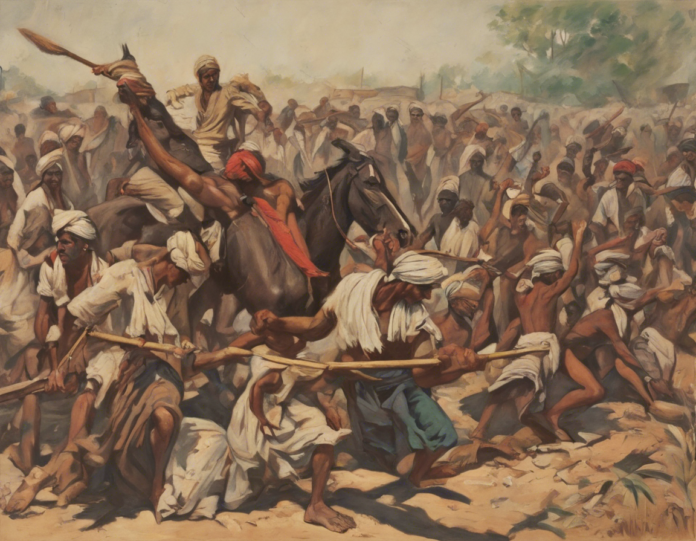India’s struggle for independence was a tumultuous and inspiring period in the country’s history. Spanning decades and mobilizing millions, this fight against British colonial rule was marked by sacrifice, resilience, and a relentless pursuit of freedom. From the early movements of resistance to the final moments of triumph, the Indian struggle for independence shaped the destiny of a nation and left an indelible mark on the world stage.
Early Beginnings
The roots of India’s struggle for independence can be traced back to the early resistance against British intrusion in the subcontinent. The Battle of Plassey in 1757, where the British East India Company defeated the Nawab of Bengal, marked the beginning of British colonial rule in India. Subsequent revolts and uprisings, such as the Sepoy Mutiny of 1857, demonstrated the simmering discontent among the Indian populace against British dominance.
Rise of Nationalism
The late 19th and early 20th centuries witnessed a surge in nationalist sentiment across India. Leaders like Bal Gangadhar Tilak, Lala Lajpat Rai, and Surendranath Banerjee championed the cause of Indian nationalism and called for self-governance. The formation of the Indian National Congress in 1885 provided a platform for articulating the demands of the Indian people and advocating for political reforms.
Non-Cooperation and Civil Disobedience
The early decades of the 20th century saw the adoption of non-cooperation and civil disobedience as strategic tools in the fight against British rule. Mahatma Gandhi, with his philosophy of Satyagraha (soul force), emerged as the beacon of India’s independence movement. The Salt March of 1930, where Gandhi led a protest against British salt monopoly, became a symbol of nonviolent resistance and civil disobedience.
Partition and Independence
The struggle for independence reached its crescendo in the years leading up to 1947. The Quit India Movement of 1942, calling for an end to British rule, galvanized the Indian masses and signaled the beginning of the end of colonialism. Amidst communal tensions and political negotiations, India finally gained independence on August 15, 1947. However, the joy of freedom was marred by the tragic partition of the subcontinent into India and Pakistan, leading to one of the largest migrations in human history and communal violence.
Legacy of Independence
The attainment of independence marked a new chapter in India’s history. The Constitution of India, adopted in 1950, enshrined the principles of democracy, secularism, and social justice. Leaders like Jawaharlal Nehru, Sardar Patel, and B.R. Ambedkar played pivotal roles in shaping the post-independence trajectory of the nation. However, the partition legacy, ongoing communal tensions, and socio-economic challenges posed formidable obstacles to nation-building.
FAQs (Frequently Asked Questions)
1. What were the main causes of the Indian struggle for independence?
The main causes of the Indian struggle for independence were British colonial exploitation, economic deprivation, racial discrimination, and denial of political rights to the Indian populace.
2. Who were the key leaders of the Indian independence movement?
Key leaders of the Indian independence movement included Mahatma Gandhi, Jawaharlal Nehru, Sardar Patel, Subhas Chandra Bose, Bhagat Singh, and many others who played significant roles in mobilizing the masses and articulating the aspirations of the people.
3. How did Mahatma Gandhi’s philosophy influence the Indian independence movement?
Mahatma Gandhi’s philosophy of Satyagraha, Ahimsa (nonviolence), and civil disobedience provided the moral and strategic framework for the Indian independence movement, inspiring millions to resist colonial rule through peaceful means.
4. What was the significance of the Salt March in India’s struggle for independence?
The Salt March, led by Mahatma Gandhi in 1930, was a turning point in India’s struggle for independence as it symbolized nonviolent resistance against British economic exploitation and sparked a wave of civil disobedience across the country.
5. How did the partition of India impact the struggle for independence?
The partition of India in 1947, leading to the creation of India and Pakistan, had a profound impact on the struggle for independence as it resulted in widespread communal violence, displacement of populations, and scarred the collective memory of the subcontinent.
6. What were the main challenges faced by independent India after gaining freedom?
Independent India faced a multitude of challenges including economic underdevelopment, social inequalities, political instability, communal tensions, and the daunting task of nation-building amidst a diverse population.
7. How did the Indian independence movement influence other anti-colonial struggles around the world?
The Indian independence movement served as a source of inspiration for other anti-colonial struggles around the world, notably in Africa and Asia, by demonstrating the power of nonviolent resistance, mass mobilization, and the quest for self-determination.
8. What role did women play in the Indian struggle for independence?
Women played a significant but often overlooked role in the Indian struggle for independence, with leaders like Sarojini Naidu, Annie Besant, and Aruna Asaf Ali contributing to the nationalist cause and advocating for gender equality and social reforms.
9. How has the legacy of the Indian independence movement shaped modern India?
The legacy of the Indian independence movement continues to resonate in modern India through its democratic institutions, cultural heritage, pluralistic ethos, and ongoing struggles for social justice, equality, and inclusive development.
10. What lessons can be drawn from the Indian struggle for independence?
The Indian struggle for independence offers invaluable lessons in courage, resilience, unity, and the power of nonviolent resistance in the face of oppression, serving as a timeless reminder of the human spirit’s capacity for liberation and transformation.









